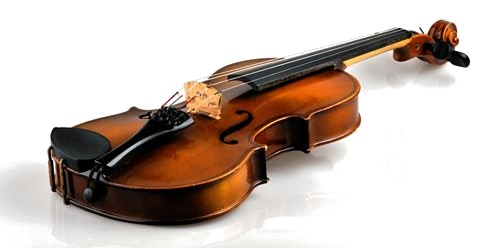

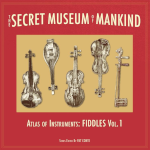
I am in love with this incredible new compilation of archival recordings Secret Museum of Mankind – Atlas of Instruments, Fiddles, Vol. 1, compiled by reclusive NY State music collector Pat Conte, who has over 30k recordings from around the world.
It’s totally mesmerizing. Music comes from Crete, Sicily, Syria, China, Uganda, Serbia, India, Norway, Ireland, Portugal, and beyond (including several immigrants recorded in NYC). It’s changed the way I hear the instrument and how I perceive what's possible on it.
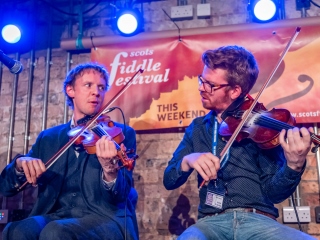
A fiddle is a bowed string musical instrument, most often a violin. It is a colloquial term for the violin, used by players in all genres, including classical music. Although in many cases violins and fiddles are essentially synonymous, the style of the music played may determine specific construction differences between fiddles and classical violins. For example, fiddles may optionally be set up with a bridge with a flatter arch to reduce the range of bow-arm motion needed for techniques such as the double shuffle, a form of bariolage involving rapid alternation between pairs of adjacent strings. To produce a "brighter" tone than the deep tones of gut or synthetic core strings, fiddlers often use steel strings. The fiddle is part of many traditional (folk) styles, which are typically aural traditions—taught "by ear" rather than via written music.
Fiddling is the act of playing the fiddle, and fiddlers are musicians that play it. Among musical styles, fiddling tends to produce rhythms that focus on dancing, with associated quick note changes, whereas classical music tends to contain more vibrato and sustained notes. Fiddling is also open to improvisation and embellishment with ornamentation at the player's discretion, in contrast to orchestral performances, which adhere to the composer's notes to reproduce a work faithfully. It is less common for a classically trained violinist to play folk music, but today, many fiddlers (e.g., Alasdair Fraser, Brittany Haas, and Alison Krauss) have classical training.
The medieval fiddle emerged in 10th-century Europe, deriving from the Byzantine lira (Ancient Greek: λύρα, Latin: lira, English: lyre), a bowed string instrument of the Byzantine Empire and ancestor of most European bowed instruments.
The first recorded reference to the bowed lira was in the 9th century by the Persian geographer Ibn Khurradadhbih (d. 911); in his lexicographical discussion of instruments he cited the lira (lūrā) as a typical instrument of the Byzantines and equivalent to the rabāb played in the Islamic Empires.
Lira spread widely westward to Europe; in the 11th and 12th centuries European writers use the terms fiddle and lira interchangeably when referring to bowed instruments.
West African fiddlers have accompanied singing and dancing with one-string gourd fiddles since the twelfth century, and many black musicians in America learned on similar homemade fiddles before switching over to the European violin. As early as the mid-1600s, black fiddlers ("exquisite performers on three-stringed fiddles") were playing for both black and white dancers at street celebrations in the Dutch settlement of New Amsterdam (New York City), and by 1690 slave fiddlers were routinely providing the music at plantation balls in Virginia.
Over the centuries, Europe continued to have two distinct types of fiddles: one, relatively square-shouldered, held in the arms, became known as the viola da braccio (arm viol) family and evolved into the violin; the other, with sloping shoulders and held between the knees, was the viola da gamba (leg viol) group. During the Renaissance the gambas were important and elegant instruments; they eventually lost ground to the louder (and originally less aristocratic) viola da braccio family.
The etymology of fiddle is uncertain: it probably derives from the Latin fidula, which is the early word for violin, or it may be natively Germanic.
The name appears to be related to Icelandic Fiðla and also Old English fiðele. A native Germanic ancestor of fiddle might even be the ancestor of the early Romance form of violin.
In medieval times, fiddle also referred to a predecessor of today's violin. Like the violin, it tended to have four strings, but came in a variety of shapes and sizes. Another family of instruments that contributed to the development of the modern fiddle are the viols, which are held between the legs and played vertically, and have fretted fingerboards.
In performance, a solo fiddler, or one or two with a group of other instrumentalists, is the norm, though twin fiddling is represented in some North American, Scandinavian, Scottish and Irish styles. Following the folk revivals of the second half of the 20th century, it became common for less formal situations to find large groups of fiddlers playing together—see for example the Calgary Fiddlers, Swedish Spelmanslag folk-musician clubs, and the worldwide phenomenon of Irish sessions.
Orchestral violins, on the other hand, are commonly grouped in sections, or "chairs". These contrasting traditions may be vestiges of historical performance settings: large concert halls where violins were played required more instruments, before electronic amplification, than did more intimate dance halls and houses that fiddlers played in.
The difference was likely compounded by the different sounds expected of violin music and fiddle music. Historically, the majority of fiddle music was dance music, while violin music had either grown out of dance music or was something else entirely. Violin music came to value a smoothness that fiddling, with its dance-driven clear beat, did not always follow. In situations that required greater volume, a fiddler (as long as they kept the beat) could push their instrument harder than could a violinist. Various fiddle traditions have differing values.
In the very late 20th century, a few artists have successfully attempted a reconstruction of the Scottish tradition of violin and "big fiddle", or cello. Notable recorded examples include Iain Fraser and Christine Hanson, Amelia Kaminski and Christine Hanson's Bonnie Lasses, Alasdair Fraser and Natalie Haas' Fire and Grace, and Tim Macdonald and Jeremy Ward's The Wilds.
Hungarian, Slovenian, and Romanian fiddle players are often accompanied by a three-stringed variant of the viola—known as the kontra—and by double bass, with cimbalom and clarinet being less standard yet still common additions to a band. In Hungary, a three-stringed viola variant with a flat bridge, called the kontra or háromhúros brácsa makes up part of a traditional rhythm section in Hungarian folk music. The flat bridge lets the musician play three-string chords. A three-stringed double bass variant is also used.
To a greater extent than classical violin playing, fiddle playing is characterized by a huge variety of ethnic or folk music traditions, each of which has its own distinctive sound.
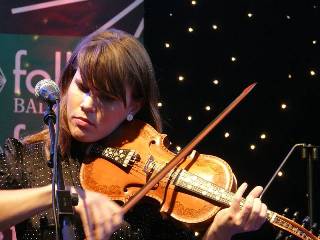
The mesmerizing Secret Museum of Mankind – Atlas of Instruments, Fiddles, Vol. 1 will be released September 15 on Jalopy Records via LP and digital, presenting music from Crete to Madagascar, Mexico, England, Sicily, Norway, India, the USA, Cape Verde, China and more. It extends the beloved Secret Museum of Mankind series, which explores global music from the first half of the twentieth century, compiled by a kind of ethnic-music scholastic… audiophile, guitarist, postal worker” (New York Times) Pat Conte since 1996. this new compilation marks the tenth volume.
A double-sided first single is out today consisting of “Volana Fenomanana” by [Fandihizana Malagasy] Orchestre de M. Michel Ratsimba, circa 1930 from Madagascar and “Okukomawe” by Abadongo Abaganda Kampala, circa 1948 from Uganda. The latter is based on an epic poem and is accompanied by vocals and odi, a hand-held harp then made with antelope horn and elephant ear:
The Times described early volumes as “often anonymous performers whose renditions of songs — coughs and mutterings included — are devoid of the show-biz flourishes that adorn even amateur music today.”
The second single will come out digitally August 16 and consist of “Brown Skin Girl” by Mississippi champion fiddler Jabe Dillon accompanied by his son on guitar, circa 1949, with the b-side Norway’s Gunnulf Borgen playing “Igletveiten.”
The album kicks off with “Pentozali,” recorded in 1926 in Crete, which would accompany Πεντοζάλης or five-step dances, among the most ancient dances known. Quebec, Canada’s Joseph Allard, born in the 1870s, was among the first Canadian musicians to ever record. New York City serves as the site for recordings by Syrian-Lebanese and Irish musicians, respectively. Noted early ethnomusicologist and author Cecil Sharp used England multi-instrumentalist and dancer William Nathan aka “Jinkey” Wells, born in 1868, as a source.
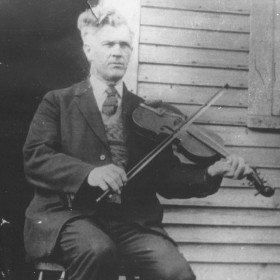
Mariachi Coculense Rodriguez’s “El Jilguerillo” may be the earliest mariachi to be recorded. Conte describes the track as “Harmony twin-fiddling with guitarrón, before the advent of the more familiar brass.”
France multi-instrumentalist Paul LeVault often played on historic instruments from the 1700s, including rare wheel-fiddles and cabrettes whose function remained basically unchanged since the Renaissance.
Conte’s collection numbers over 30,000 78rpm records, over 5,000 LPs, plus 45s, cassettes, and numerous reel-to-reel tapes. In a profile that ran in 2000, New York Times described the collection, saying, “The museum, which fills the basement of his mother’s Long Island ranch house, includes dinosaur bones, tribal masks, a pipe collection, antique microphones and stereo gear from the 1950’s and 60’s. But at its heart is the music of a lost time, when adventurers and entrepreneurs fanned out across the continents with 78-r.p.m. and wax cylinder recording equipment in search of indigenous music.”
The Secret Museum series has had a home with Jalopy Records since 2021, releasing via Yazoo Records prior. The vinyl release will be a beautiful gatefold package featuring liner notes booklet by curator Pat Conte, original drawings of rare and unique fiddles in Conte’s collection, by artist Jeff Tocci, and a selection of historic images of fiddlers, also curated by Conte and drawn from his collection. Audio restoration, mastering, and engineering was done by Don Fierro.
Of the first Secret Museum album released all the way back in 1996 onto CD, All Music said, “The superb musicianship and creative approaches displayed on these varied recordings makes this CD a must-have for any real ‘world music’ fan.” That remains true over 25 years later. Songlines Magazine called the 2021 edition, which focused on guitars, “brilliantly odd, akin to a film soundtrack with its dramatic shifts in tempo and intense rhythms.”
Other volumes inspired All Music to write of “the historical import of these recordings… superb” (Music of Central Asia, 1925-1948), “wonderfully eclectic and inspiring” (Music of North Africa, 1925-1948), “stands as another example of The Secret Museum’s valuable contribution to both historical preservation and the production of great music… outstanding compilation” (Ethnic Music Classics, Vol. 5), and “a fascinating glimpse of styles that were sparsely documented, or now extinct. And it’s not purely an ethnomusicological museum piece: most if not all of the tracks are primarily there to be enjoyed as entertaining, emotional performances, on par with today’s high-class world music albums” (Ethnic Music Classics: 1925-1948, Vols. 1-2).
Ethnic Music Classics, 1925-1948, Vol. 3 prompted All Music to exclaim, “The historical context within these works presented — worldwide recordings made between 1925 and 1948 — give this and the other Secret Museum works a cohesion that allows for disparate musical examples to be placed side by side.”
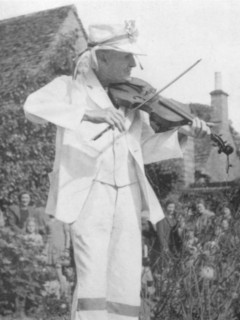
Secret Museum of Mankind – Atlas of Instruments: Fiddles Vol. 1 Track Listing
A1 Pentozali • Trio Th. Picoula • CRETE (c. 1926)
A2 Le Reel Du Pendu • Joseph Allard QUEBEC (1927)
A3 Pianto Ignoto • Joseph Ziccone & F. Guandi SICILIAN (NYC 1928)
A4 Volana Fenomanana • (Fandihizana Malagasy) Orchestre de M. Michel Ratsimba MADAGASCAR (1930)
A5 The Maid of The Mill • Jinkey Wells Oxfordshire, ENGLAND (c.1943-1952)
A6 Raks Jamili • Anon Group • Syrian-Lebanese Brooklyn, NY (c.1946)
A8 Sam Liang Gow • San Chi La & Shim Yi Chu PEKING (c. 1929)
A9 Le Chibrely • Paul LaVault, Vielle Commagny, FRANCE (c. 1929)
B1 Okukomawe • Abadongo Abaganda Kampala, UGANDA (ca. 1948)
B2 Bunjecacko Kolo • Stevan Bačić-Trnda • Sombor, SERBIA (1930)
B3 Thanam II • Tiramakudalu Chowdiah • Mysore, INDIA (c. 1937)
B4 Brown Skin Girl • Fiddlin’ Jabe Dillon • Mississippi, USA (c. 1949)
B5 Igletveiten • Gunnulf Borgen, hardingfele • Oslo, NORWAY (1939)
B6 Danza De Matachines • Yaqui Group • New Mexico, USA (1933)
B7 Fattenin’ Frogs • Mobile Strugglers • Alabama, USA (1949)
B8 Sligo Maid’s Lament; Trip To The Cottage • Paddy Killoran • NYC, USA (1936)
B9 Valsa Continental • Abrew’s Portuguese String Trio • CABO VERDE (1931)
Secret Museum of Mankind – Atlas of Instruments: Fiddles Vol. 1 Liner Notes
The museum’s musical atlas of instruments continues with the opening of another wing, the first in a series on bowed instruments. To stretch boundaries over the earth and over time is to forsake them; whether it is a matter of Synchronizitätor just the plain unconscious. In Western cultural history, the bowed instrument is a late installment, after centuries, of an almost primordial vibration that we imagine in sound; see in the old paintings; and yet can sample in the remnants of the ancient world captured on gramophone records.
Aptly the Πεντοζάλης, or 5-step dances, are among the most ancient, and bare some deeper context to the people of Crete. One of the older sounds here, featuring the Lyra by an unknown trio and an unnamed tune (ca. 1926).
The legends of the “Hanged Fiddler” are a rich and widespread tradition in Folklore. Fisherman Joseph Allard, born in the 1870s, was recognized as a master and mentor to future masters and was counted with the first Canadian fiddlers to record (1926). He utilizes a special tuning often favored by fiddle contestants, which is identified by specific names in old time style and bluegrass, as well as in Scandinavian music.
Violinist Joseph Ziccone and guitarist F. Guandi were recorded in July of 1928 in NYC. They were eventually billed as the Duo Siciliani; The Waltz, “Secret Tears”, is the second of their two records to have survived.
Part of a larger troupe, this group billed as Orchestre de M. Michel Ratsimba recorded in 1930, but the performance sounds beyond the scope of known numbers! The central trio consists of a western violin with guitar and the tube-zither, the valiha.
William Nathan Wells, according to Grove’s, was born in 1868 and is probably the oldest fiddler here; he was a source for Cecil Sharp who visited with him near the turn of the century. A multi-instrumentalist who often played the fool for the Morris Teams, “Jinkey” Wells also documented the history of Morris dance himself via manuscript. He recorded sparsely in the 1940s and passed short years after this recording.
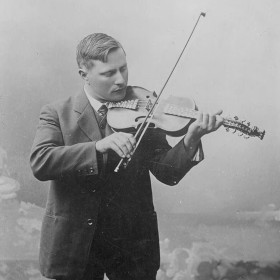
Raks or Raqs is another example of a more modern version of a traditional Egyptian dance, born in the earlier half of the 2oth Century; often the violin being reconfigured by shifting the 4 strings into two courses and lending itself to various reed and bagpipe imitations, another almost universal trait for showpiece fiddlers. This unnamed Syrian-Lebanese group, probably living and recording in the Atlantic Avenue Arabic community of Brooklyn shortly after WWII, has most likely named the tune in honor of Jamileh Matouk, the famed singer from Tripoli who was most likely present in the studio.
Mariachi Coculense Rodriguez performs “El Jilguerillo”, named for the songbird that migrates south known as the Linnet, or Goldfinch depending on your Audubon guide edition. Perhaps the earliest mariachi to record, here they are at mid-stream in the height of their powers during their ‘electrically recorded’ period. Harmony twin-fiddling with guitarrón, before the advent of the more familiar brass.
Sam Liang Gow (Educating Her Son) is a dialogue between two Chinese huqin or two-string instruments, and reflects the introduction of such so-called “modernized” instruments to Peking in the 1920s. These huqin are in effect a more ancient version of erhu, or gaohu in conversation with zhongu, the throatier lower-pitched instrument.
Paul LeVault, from Commagny, and a one-time member of the Garde Republicaine, was a multi-instrumentalist and known master of the accordion and pipes as well. LeVault often played on historic instruments from the 1700s which he avidly collected, including rare wheel-fiddles and cabrettes whose function remained basically unchanged since the Renaissance.
Okukomawe, or “The Return Of The King Mutesa” was recorded ca.1948 or so in Kampala. Apparently based on epic poetry attributed to J. Kasasa (who may be present), it may in fact refer to the Kabaka Muteesa I of Buganda, or his descendant. The endingidi (tube fiddle) solo is usually accompanied by an odi, the hand-held harp resembling Nyatiti or other bowl harps found in East Africa, which at this time would still have been crafted with traditional materials including antelope horn and elephant ear.
Serbian violinist Stevan Bačić-Trnda and his tamburicaorchestra play a local specialty of Tavankut, a village near Subotica. They recorded while the troupe visited Austria in the fall of 1930. A master of many tunes and styles, this was amoung his last recordings before he passed away in his native Sombor in 1935.
By the 1930s, at the time of this recording, Tiramakudalu Chowdiah, from near Mysore, was already recognized as a Carnatic master and developed this 7-string version of the violin (“Pitilu”) in an effort to extend its voice and range, much to the displeasure of his guru. Accepted shortly thereafter, it was used continually for the next 30 years until his death. He erected a sacred music space in the form of a temple to his guru, at great expense – and there exists today a monument to Chowdiah himself as well, a building in the shape of a violin.
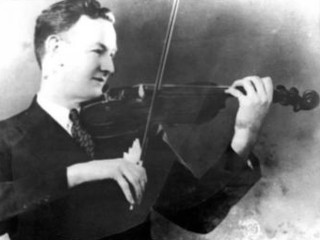
Champion fiddler near Tylertown, Mississippi, Jabe Dillon(b. 1898) was a winning contest fiddler, known for many unusual tunes which were unique to him. Brown Skin Girl(later known also as “Refused Love”) was reworked as a solo in c. the late 60s and released on his own label to be distributed to local radio stations. This original version, however, (ca. 1949) features his son Lloyd Dillon Jr. on guitar and unknown string bass.
One of the National treasures of Telemark; Igletveiten is an older springar dance (Couple Dance) with variants. Gunnulf Borgen was born in 1881 and from the village of Heddal, recorded in Oslo in 1939. His hardingfele is an elaborate instrument with underlying sympathetic strings, fancy inlays and penwork and a striking carved head. Borgen often employs various tunings, amoung them some fanitulientunes which employ a “devil’s tuning” not dissimilar to the tuning used for “Le Reel Du Pendu” above.
The Matachines continue a tradition spanning up from the 1600s; These are location recordings made in Tlaxaca, Puebla in 1933 by an anonymous Yaqui group with fiddle, harp, and stamping by the dancers. The frame harp, and indeed Yaqui Indian music in general, was virtually unheard on disc before the previous decade.
“Fattenin’ Frogs” features a unique group interweaving two fiddlers, Charles Jones and James Fields, and includes guitarist Paul Johnson, banjo-mandolin by Lee Warren and Wesley Williams, string bass. Bill Russell, who can be heard in the opening seconds signaling “go” over the chirps of the early evening crickets, was one of the most fascinating people I had ever written to; an avant garde composer (e.g. wrote a piece scored for “suitcase, Jack Daniels bottle & Haitian Drum”), author and violin repairman who ran a record shop and his own label. Russell preserved some remarkable field recordings of his own such as this one, helped write the history of jazz and connects full circle the worlds of Henry Cowell and John Cage with the rarest deep south origins of American Music.
Sligo Maid’s Lament; Trip To The Cottage is a set of reels recorded by Paddy Killoran in NYC in 1936, with James Ryan on guitar (tenor) and brother of Killoran bandmate, Paul. The Lament is also related to a mountain reel from Donegal. Born in 1903, a youthful Patty, member of the Sligo Brigade, shared a mentor with Michael Coleman and was a tavern owner in Manhattan in his later years.
The last waltz is courtesy of fiddler Augustus Abreu from “Abrew’s Portuguese String Trio.” A Cape Verdean who emigrated from Fogo in the twenties, Abreu recorded a single session in 1931 with his band and leaves a short but essential legacy of a misty and disappeared island string tradition.
–Pat Conte
Photo Credits:
(1) Secret Museum of Mankind – Atlas of Instruments, Fiddles, Vol. 1,
(2) Adam Sutherland & Ross Couper
@ Scots Fiddle Festival 2019,
(3) Joseph Allard,
(4) William Nathan 'Jinkey' Wells,
(5) Gunnulf Borgen,
(6) Paddy Killoran,
(7) Benedicte Maurseth
@ folkBALTICA 2011
(unknown/website).